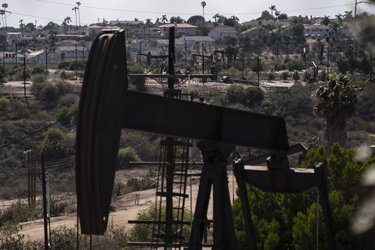Category Archive 'Environmentalism'
17 Jun 2021


Bakersfield
Joel Kotkin explains how Coastal California environmental superstition combined with snobbery is devastating the economy, and wiping out the jobs, of Blue Collar in-land Kern County.
Located over the mountains from Los Angeles, Kern County has always been a different kind of place. Settled largely by “Okies and Arkies” from the Depression-era South, the area has a culture more southern than northern, more Ozarks than Sierra. Home to just under 1 million people at the southern end of the state’s Central Valley, Kern is noted for producing the “Bakersfield sound,” epitomized by the late country star Merle Haggard, and is sometimes even referred to as “little Texas.”
Its economy rested on two natural resource industries that once powered California – agriculture and oil. The region leads California in energy production and is fourth in agriculture, mainly yielding lettuce, strawberries, and grapes. Its concentration of agricultural jobs is 22 times the national average and its oil industry jobs are 6 times the national average.
Although these may seem like “old economy” jobs, the Kern area has easily outperformed zippy “new economy” places in total job growth; outside of the Silicon Valley, notes Chapman analyst Marshall Toplansky, Kern is one of few California areas producing mid-wage jobs above the national average – far more than San Francisco, Los Angeles, and Orange Counties, which have fallen behind the national pace. …
In a state suffering from high housing prices and a lack of middle-wage jobs, one would think boosting Kern County and its largest city, Bakersfield (population: 700,000) would be a priority. Governor Gavin Newsom boasts that he wants to look for ways of “unlocking the enormous potential” of the Central Valley, but he seems more interested in flattening the area’s aspirations.
Climate policy sits at the core of this assault. Reflecting the prejudicial neuroses of his Bay Area and oligarchic base, Governor Newsom – who Dan Walters describes as “California’s champion virtue signaler” – has announced plans to shut down the state’s oil industry. Newsom’s latest unlegislated decree directed state regulators to ban all forms of oil and gas well stimulation technologies, including steam injection, essential for oil and gas extraction in the state. The draft rules, issued last month, would effectively sharply limit California’s oil and gas industry as well as future exploration and development. According to a study by the Los Angeles Economic Development Corporation, these dictates threaten over 366,000 high-paying, largely blue-collar jobs, about half held by people of color. Another 3.9 million jobs, 16.5% of total state employment, are at risk from these policies.
People in Bakersfield may depend on these jobs, but rigid Ecotopians – backed by investment bankers, social media magnates, and urban real estate interests, the funders of “progressive” politics – want them eliminated. The green push also threatens to destroy the area’s ability to fund local services. Renewable firms thrive in the area – producing 25 percent of all California’s renewable energy, according to the Kern EDC, and serving as home to the nation’s largest solar plant, wind farm, and geothermal facility. But these facilities tend to pay little or no property tax, while oil represents the largest source of local revenue. Green energy won’t do much for the county when faced with the demand for more welfare and other services that would accompany increased joblessness stemming from the demise of oil.
Nor is energy the only area Newsom is seeking to undermine the local economy, particularly now that California is about to have another of its regular droughts. The last one ended in 2017. Since then, first under Jerry Brown and now Newsom, the state has done little to increase reservoir storage capacity during wetter years. Captured water is increasingly released into San Francisco Bay, rather than used for homes and farms, in a quixotic attempt to “save” species in decline despite decades of “scientific” protection.
Like the energy sector, agriculture finds itself in the crosshairs of the greens, who link dry weather to climate but oppose the construction of new reservoirs, preferring to use runoff for natural areas like San Francisco Bay and the adjoining delta. The preferred solution to droughts today is not de-salinization or boosting water storage, but wiping out farmland, creating a dystopic landscape of abandoned fields in some of the world’s richest agricultural areas.
The losers here are not just the “corporate” farms long disdained by California’s progressives. In the last drought, which ended in 2017, thousands of poor and predominantly Latino workers lost their jobs. The most recent drought is hitting just as Central Valley farmers struggle with new groundwater regulations that dramatically cut their ability to cope with reduced runoff from rain and snowmelt. According to the Public Policy Institute of California, groundwater limits will eliminate between 535,000 and 750,000 acres of Valley farmland. Small farmers, who won’t be able to pay for or even secure ever-scarcer water, likely would be the worst hit.
RTWT
30 Jan 2021


The quality and species of firewood matters to me, because my Pennsylvania log cabin has a stone groundfloor. The two-foot-thick walls keep it nicely insulated, but also tend to make it chilly as a well in cold weather, so I pretty much have to keep a log fire going from October to April.
Softwoods, like pine, burn too fast and release too much creosote, drastically upping your likelihood of chimney fires. Insufficiently aged wood, or wood cut live, is heavy to lift and hard to get to burn. You rapidly run through your tinder, starting and re-starting the fire as the moist log smokes at you.
They used to sell wood by the cord –4′ by 8′ by 4′, but nobody really measures in cords today. We buy now by the pickup load.
Jeremy Clarke, in the British Spectator, buys wood in France by the stère, and talks hunting (Outline gets around the paywall):
The other day we ordered a stère from a woodman recommended by an expat English friend. He dumped his load at the foot of the path and climbed up to the house for payment and a drink; €70 a stère is the norm. He wanted €90 and a whisky, ice, no water. I made him a belter and passed it over along with the cash. Would he like to sit? He consented to perch on the arm of the sofa. Our elderly bitch, deeply asleep on the sofa, was woken nostril first by the combination of rare and unusual scents emanating from this thick-set man in his mid-fifties.
He managed his heavy-bottomed whisky glass with an exaggerated delicacy that looked a bit like parody. But his expectant conviviality suggested a previous acquaintance with the expat English bourgeoisie, who, for all their faults and absurdities, offer strong spirits at 10 o’clock in the morning and defer obsequiously to the opinions of a man of the woods and forests. Then Catriona came in and sat and accepted a whisky also.
The woodman had noted with approval the stuffed boar’s head wearing Ray-Bans fixed above the side door. This moved the conversation in the direction of boars and boar-hunting and it turned out that we were entertaining the president of a local boar hunt. He owns 19 hunting dogs, a small arsenal of rifles and shotguns, and only yesterday had organized an 80-gun shoot followed by a wood-cutting session and piss-up. Another whisky, young man, we said? The empty glass was smartly presented while our old dog fastened her nose to his trousers.
Catriona interrogated him about his sex life. He was currently living with a much younger woman, an obstreperous vegetarian, he said. Then, suspiciously: we weren’t ecologists, were we? (An ecologist in his book was a shorthand term of abuse for an animal rights supporter.) I put it on record that I was not an ecologist and in fact had taken part in a boar hunt in which the chef had one leg shorter than the other and three dogs were gravely injured by boars’ tusks during the course of the day. Ah, said the woodman. His dogs were fitted with Kevlar jackets. Expensive but he no longer spends half the time sewing up his injured dogs.
RTWT
23 Nov 2020


“If I could work my will,” said Scrooge indignantly, “Every idiot who goes about with ‘Merry Christmas’ on his lips, should be boiled with his own pudding, and buried with a stake of holly through his heart. He should!”
Campus Reform finds that Scrooge has been reincarnated and is teaching at Columbia.
A Columbia University faculty member has called for an end to the Rockefeller Center Christmas tree, calling the tree emblematic of an “absolutely toxic relationship” with nature.
Arguing that the tree is a “veritable island for wildlife,” Columbia University faculty member and environmental journalist Brian Kahn decried the loss of the ecological haven. Kahn is set to teach a class in spring 2021 titled “Applications in Climate and Society.”
He warned that the tree had lost its one “iota of dignity” it had in its previous home. …
Khan further argued that the Rockefeller tradition reflects how “we’ve subjugated nature to our whims.†He said the tree stands as “an icon of American exceptionalism,” pointing not only to the tree’s tie to filling the underground mall, thus “keeping the unnatural system alive,” but also to its place as a “paean to patriotism†following 9/11.
Khan added that watching the tree didn’t bring him “elation.†Instead, it made him feel “sad that we venerate the continued subjugation of nature at the expense of unfettered growth and consumption.†The tree is “a flashy, two-hour TV special,†which presents a “shiny veneer of corporate social responsibility and giving.â€
“But really,” he added, “it just illustrates our broken system and priorities that are also strangling the planet…”
10 Apr 2020


James Hamblin M.D., who would believe it?, is actually 37 years old. He looks about 16. Despite being a Med School grad, he does not actually practice medicine, but instead writes for The Atlantic and lectures on Public Health at Yale.
Dr. Hamblin, in a 2017 article being freshly redistributed by Pocket, tells us that we should all give up eating beef, replacing it with beans(!) thereby coming close to meeting America’s 2020 greenhouse-gas emission goals, pledged by President Barack Obama in 2009.
[I]f nothing about our energy infrastructure or transportation system changed—and even if people kept eating chicken and pork and eggs and cheese—this one dietary change could achieve somewhere between 46 and 74 percent of the reductions needed to meet the target.
“I think there’s genuinely a lack of awareness about how much impact this sort of change can have,†Harwatt told me. There have been analyses in the past about the environmental impacts of veganism and vegetarianism, but this study is novel for the idea that a person’s dedication to the cause doesn’t have to be complete in order to matter. A relatively small, single-food substitution could be the most powerful change a person makes in terms of their lifetime environmental impact—more so than downsizing one’s car, or being vigilant about turning off light bulbs, and certainly more than quitting showering.
So, here is this presumptuous elite scribbler with a couple of degrees and an adolescent’s face who is perfectly prepared to tell 330 million of his fellow citizens to hurry up and fall into line, giving up a primary focus of the American diet, a food item appearing on the table in countless forms and recipes, whose cultural role and traditional use extends backward immemorially. The paleolithic paintings at Lascaux include bison and aurochs, the ancestors of today’s Black Angus. And why? in order to comply with a 2009 international agreement proposing self-flagellating energy measures for advanced Western countries with no possible impact on the Asian and other Third World industrial activities producing far more of the emissions suppositiously threatening to provoke the wrath of Gaia.
Really intelligent people question the ability of computer models playing with statistics to predict the earth’s climate, and the same people are also highly skeptical of the whole Anthropogenic CO2 causing warming business, since it is obvious that the world’s climate has been significantly warmer than today during several periods in the past. The Vikings, for instance, settled and farmed in Greenland, then were frozen out. There’s nobody farming in Greenland today. The Romans extensively made wine in Britain. Growing wine grapes in Britain is a very minimal activity today, and not long ago was non-existent.
Anyone numerate would recognize that the Paris Treaty was never anything but a Feel-Good bien pensant gesture. Even if fully implemented, it could never have accomplished its supposed goal.
And, anyone with common sense would realize that trying to tell Americans to give up steak and hamburger, kill off all their cattle, and shut down a several-hundred-billion-dollar-a-year industry as a gesture of solidarity with International Goo-Goo-ism is a complete non-starter.
It is really typical of today’s society that somebody goofy enough to write that piece would be hired to lecture at Yale.
06 Apr 2020


Crazy left-wing busybodies rule the world. Didn’t you know? If there is anything going on that useful, productive, or merely fun, they’ve got Environmentalism to use to get their way. Essentially anything human beings do can be argued to produce changes in the world, and any changes can be claimed to be somehow, in some sense, negative. Voilà ! Mustn’t offend Gaia! That’s been banned!
Driven grouse shooting in England & Scotland is not only a sport. It’s also an economic activity. The sale of wild game was banned early in the last century in the United States. Market hunters were responsible for the eradication of the buffalo and the near extinction of some other species, and they competed with sport hunters. In Britain, on the other hand, game bird management on enormous estates included harvesting by sportsmen followed by commercial sale. British restaurants compete to offer red grouse the soonest after the shooting season opens on the traditional date of August 12th.
The goo-goos have all these rationalizations about heather-burning being bad for the environment, but they are all anti-blood sports, and enviromentalism always provides excuses for lefties to nobble things they don’t like, from timber-harvesting to grouse shooting.
The Guardian is gloating.
The controversial practice of setting heather-covered moorland on fire – often carried out by gamekeepers to create more attractive habitats for grouse – is now banned on more than 30 major tracts of land in northern England. Three large landowners have confirmed that their tenants are no longer allowed to burn heather routinely.
The ban is a blow to grouse shoots, which burn older heather to make way for younger, more nutritious plants for grouse to feed on, but environmental groups say the practice harms the environment. Research by the University of Leeds has found that burning grouse moors degrades peatland habitat, releases climate-altering gases, reduces biodiversity and increases flood risk.
Last year, the Observer reported that Yorkshire Water was reviewing each of its grouse-shooting leases amid concerns about the practice of routine burning. The company says has written into its lease a presumption against burning as a land management technique.
United Utilities is also altering its leases to shorter terms, with a similar review to Yorkshire Water’s expected. Last month, it confirmed to the campaign group Ban Bloodsports on Yorkshire’s Moors (BBYM) that it now prohibits routine burning on its land.
And three estates overseen by the National Trust – Marsden, Braithwaite Hall and Dark Peak – also told the group that tenants were no longer allowed to conduct routine burning. Braithwaite Hall said tenants required written consent to do so, and that it had taken legal action against one. Dark Peak said it retained complete control of burning practices on its land. Marsden said tenants could not carry out any burning.
A National Trust spokeswoman said: “We don’t allow burning on deep peat and over recent years have moved away from using controlled grouse-moor burning as a matter of course. There are a diminishing number of historic agreements where burning may occasionally be used but we are working with these tenants to introduce more sustainable land-management practice.â€
RTWT
13 Feb 2020


Then they mean to take away your car, Jack Baruth predicts.
I’d be willing to bet that very few of you know who Richard Aborn is. He was the president of Handgun Control, Inc., in 1993 when the Brady Bill was passed. Prior to the bill’s passage, the NRA and others said that it would be the “camel’s nose under the tent†of firearms legislation. This is a reference to an old saying that you can’t just let the camel’s nose into a tent—you end up letting the whole camel in, whether you want to or not.
Anyway, when the Brady Bill was passed, Mr. Aborn grabbed a reporter and said, “[The bill’s detractors were] right all along in fearing the waiting period was a camel’s nose under the tent. Brady has now passed and it is time to reveal the rest of the camel!†At the time, I thought that was a little, ahem, bold of the man to say. Regardless of how you feel about gun control, you can probably agree with me that you shouldn’t spike the football before the referee puts his hands up. But Mr. Aborn no doubt figured he was on the right side of history in this matter.
Across the Atlantic, the legislators both elected and unelected believe themselves to be on the right side of history when it comes to the privately-owned internal-combustion vehicle—more specifically, when it comes to the demise of same. The UK just announced that it would ban the sale of gas or diesel cars by 2035, “or earlier, if possible.†When Neil Peart wrote Red Barchetta, that date was a robust 60 years away. Now it’s closer in our windshield than the introduction of the second-generation Toyota Prius is in our rearview mirror, so to speak.
This astounding regulatory decision, made by people who can’t gauge the UK’s relative impact on the climate vis-a-vis China—or maybe they just read 1984 as an instruction manual, not a warning—sickens me. There’s only one thing to be said in its defense: at least it’s kind of fair. Contrast it to the Europeans, who are doing something even nastier: their 2021 emissions standards require a fleet average of 58 mpg or thereabouts. You couldn’t do that with an all-Prius fleet. Heck, not even the Plymouth Horizon Miser could hit that mark.
What the EU expects the automakers to do is simple: continue making Ferraris, AMG Benzes, and whatnot for the super-rich while forcing everyone else into an electric vehicle. So while British showrooms will force the same misery on everyone, kind of like the way everyone in London had to hide in the same shelters during the Blitz, the Europeans will make sure that the most privileged among us get to keep doing what they want while the average man or woman in the street gets stuck with a glorified golf cart.
(If you like, and if it fits your political worldview, you’re also free to see this as a way to make the dirty plutocrats subsidize clean electric transportation for the proletariat through extra markup on their G-wagens or Range Rovers or whatever. There’s room for all views here, except perhaps for those held by the people who weld enormous scrap-sheet metal fenders on old 911s for no reason.)
The delight with which the politicians are rolling out these regulations would make Richard Aborn blush.
RTWT
05 Mar 2019


Jim Corbett with the Champawat tiger.
Leave it to the current generation of pseudo-intelligentsia. They can screw up anything. Dane Huckelbridge, for instance, takes one chapter of the great Jim Corbett’s Big Game Hunting classic Maneaters of Kumaon (1944), and makes his own book out of it, No Beast So Fierce: The Terrifying True Story of the Champawat Tiger, the Deadliest Animal in History (2019).
The difference between Jim Corbett writing a first-hand account in the 1940s and Dane Huckelbridge recycling that account today is the ideology. Jim Corbett’s story is a modest, downright self-effacing account of how a local sportsman went to the assistance of terrified Indian villagers and tracked down and killed an extraordinarily bold and aggressive man-eating tigress who’d killed and eaten a record 436 people. Corbett does attribute the tiger’s human predation to a jaw injury from an old bullet-wound, but Corbett tells a stoic and under-stated modern version of the classic man versus monster story.
For Huckelbridge though, the man versus monster saga is just a secondary problem arising from a more basic, more important conflict: British Colonialism versus Pristine Native India.
Then there is Jim Corbett, the now-legendary hunter who was finally commissioned by the British government to end the Champawat Tiger’s reign. To many, even in present-day India, he is nothing short of a secular saint, a brave and selfless figure who risked life and limb to defend poor villagers when no one else would. To others, particularly academics engaged with post-colonial ecologies, he is just another perpetrator of the Eurocentric paternalism that defined the colonial experience. Each is a fair judgment. …
Which brings us, inevitably, to colonialism itself—a topic far too broad and multifaceted for any single book, let alone one that’s concerned primarily with man-eating tigers. Yet it is colonialism, undeniably, and the onslaught of environmental destruction that it almost universally heralds, that served as the primary catalyst in the creation of our man-eater. It may have been a poacher’s bullet in Nepal that first turned the Champawat Tiger upon our kind, but it was a full century of disastrous ecological mismanagement in the Indian subcontinent that drove it out of the wild forests and grasslands it should have called home, and allowed it to become the prodigious killer that it was.
What becomes clear upon closer historical examination is that the Champawat was not an incident of nature gone awry—it was in fact a man-made disaster. From Valmik Thapar to Jim Corbett himself, any tiger wallah could tell you the various factors that can turn a normal tiger into a man-eater: a disabling wound or infirmity, a loss of prey species, or a degradation of natural habitat. In the case of the Champawat, however, we find not just one but all three of these factors to be irrefutably present. Essentially, by the late nineteenth century, the British in the United Provinces of northern India and their Rana dynasty counterparts in western Nepal had created, through a combination of irresponsible forestry tactics, agricultural policies, and hunting practices, the ideal conditions for an ecological catastrophe.
And it was the sort of catastrophe we can still find whiffs of today, be it in the recent spate of shark attacks in Réunion Island, the rise of human–wolf conflict on the outskirts of Yellowstone, or even the man-eating tigers that continue to appear in places like the Sundarbans forest of India or Nepal’s Chitwan National Park. In the modern day, we have at last, thankfully, come to realize the importance of apex predators in maintaining the health of our ecosystems—but we’re still negotiating, somewhat painfully, how best to live alongside them. And that’s to say nothing of the far more sweeping problems posed by global warming and mass extinction, exigencies that have arisen from very much the same amalgamation of economic mismanagement and environmental destruction. Apex predators are generally considered bellwethers of the overall health of the environment, and at present, with carbon emissions on the rise and natural habitats diminishing, the outlook for both feels disarmingly uncertain.
Which is why this particular story of environmental conflict is not only relevant, but urgent and necessary. At its core, Jim Corbett’s quest to rid the valleys of Kumaon of the Champawat Tiger is dramatic and straightforward, but the tensions that underscore it contain the resonance of much larger and more grievous issues. Yes, it is a timeless tale of cunning and courage, but also a lesson, still very much pertinent today, about how deforestation, industrialization, and colonization can upset the fragile balance of cultures and ecosystems alike, creating unseen pressures that, at a certain point, must find their release.
What a spectacular mélange of politically correct, fashionable think nonsense!
All of Mr. Huckelbridge’s pious notions about “ecosystems” healthy or otherwise, “apex predators,” proper forestry, suitable hunting practices, game conservation,and Environmentalism are entirely Western ideas. When he applies them to Kumaon, he himself is being colonialist.
The Champawat maneater was undoubtedly injured by an unskilled native poacher armed with a primitive musket, shooting at a tiger in defiance of hunting laws and game permits invented and imposed by the British Raj. How Huckelbridge can claim that this occurred because the poor tiger was driven out of some unidentified “forests and grasslands” by “a century of ecological mismanagement and environmental destruction” to arrive at the forests and grasslands of Kumaon is unexplained. Where exactly was it that all this alleged mismanagement and destruction occurred? Were there no native tigers in Kumaon previous to all this nearby mismanagement and destruction? What exactly does Huckelbridge think the British (and their Rana dynasty of Western Nepal counterparts) mismanaged and destroyed? Why are the British supposedly to blame for (politically independent) Nepalese actions and policies anyway?
It’s all just a farrago of Enviro-sanctimony and cant lavishly seasoned with the usual “British Colonialism was simply awful” left-wing fantasy.
In reality, the difference between Pre-Raj India and the India of Jim Corbett was that, in the former, tigers undoubtedly had more commonly the upper hand, most humans were unarmed or poorly armed, maneaters munched their way through the Indian peasantry unrebuked without records or scores of the numbers eaten ever being known or kept.
Huckelbridge’s book is nothing more than a breathless re-telling of one chapter of Maneaters of Kumaon accompanied by a truckload of PC nonsense and a lot sanctimonious self-righteousness. Consign this one to Kali!
29 Oct 2018


There is no limit to the absurd catastrophic alarms generated by the Environmental Religion. They are as many as there are grains of sand on the beach.
Here we have the BBC quoting a German academic telling us that the world may be running out of sand (!).
We extract billions of tonnes of sand and gravel each year to make concrete for the building industry, and this is having an increasing environmental impact as beaches and river beds are stripped, warn campaigners.
Alongside this environmental damage, the building industry is also a major contributor to greenhouse gases – cement manufacturing alone accounts for 7% of global CO2 emissions.
In many countries, sand is often extracted illegally from beaches or river beds. But once sand is taken from a river, the water flow can become faster and more violent – and the water table alongside a river will fall, affecting farming along the river bank.
Dredging beaches for sand increases coastal communities’ vulnerability to storm damage – because sandy beaches act as sponges absorbing a storm’s excess energy – something that is increasingly likely because of climate change.
“The problem is that the demand for sand is outpacing what we know about the environmental impact of extraction,” says Dr Aurora Torres of the German Centre for Integrative Biodiversity Research (iDiv). “It is a hidden ecological disaster.”
RTWT
The article threatening us with running out of stars in the sky is coming next week.
17 Jan 2018

In a remote part of Northern Scotland, the development of a shore-side world-class golf course that might provide a great deal of local employment is being blocked by “conservationists” fighting to preserve the supposed habitat of Fonseca’s Seed Fly, Botanophila fonsecai, a species, one of 110,000 in the world and one of more than 7000 in the UK, discovered in the 1960s, and differentiable only by a close examination of the insect’s genitalia under a microscope.
The developers have spent the last two years modifying their plans so as to minimize the golf course’s environmental impact in hope that the local Council in authority will be placated.
Today’s world is mad, and the insane environmentalist religion is one leading source of the madness.
The Verge.com
Golf.com
* French: “Bugger the flies.” — Reversal of the French saying “N’enculer pas les mouches,” a crude way of saying “Let us not split hairs.”
Your are browsing
the Archives of Never Yet Melted in the 'Environmentalism' Category.
/div>

Feeds
|




















